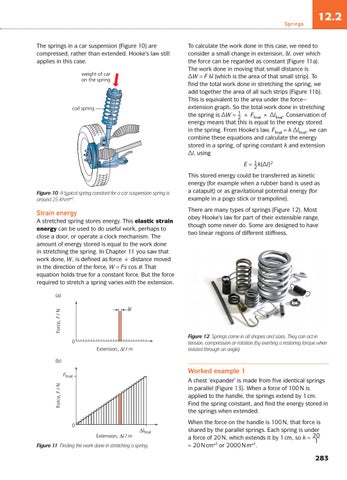Springs
The springs in a car suspension (Figure 10) are compressed, rather than extended. Hooke’s law still applies in this case. weight of car on the spring
coil spring
12.2
To calculate the work done in this case, we need to consider a small change in extension, δl, over which the force can be regarded as constant (Figure 11a). The work done in moving that small distance is ΔW = F δl (which is the area of that small strip). To find the total work done in stretching the spring, we add together the area of all such strips (Figure 11b). This is equivalent to the area under the force– extension graph. So the total work done in stretching 1 ×F the spring is ΔW = 2 final × Δlfinal. Conservation of energy means that this is equal to the energy stored in the spring. From Hooke’s law, Ffinal = k Δlfinal, we can combine these equations and calculate the energy stored in a spring, of spring constant k and extension Δl, using 1 k(Δl)2 E=2
Figure 10 A typical spring constant for a car suspension spring is around 25 kN m–1.
Strain energy A stretched spring stores energy. This elastic strain energy can be used to do useful work, perhaps to close a door, or operate a clock mechanism. The amount of energy stored is equal to the work done in stretching the spring. In Chapter 11 you saw that work done, W, is defined as force × distance moved in the direction of the force, W = Fs cos q. That equation holds true for a constant force. But the force required to stretch a spring varies with the extension.
This stored energy could be transferred as kinetic energy (for example when a rubber band is used as a catapult) or as gravitational potential energy (for example in a pogo stick or trampoline). There are many types of springs (Figure 12). Most obey Hooke’s law for part of their extensible range, though some never do. Some are designed to have two linear regions of different stiffness.
(a) Force, F / N
δl
Figure 12 Springs come in all shapes and sizes. They can act in tension, compression or rotation (by exerting a restoring torque when twisted through an angle).
0 Extension, ∆l / m (b)
Worked example 1
Ffinal Force, F / N
A chest ‘expander’ is made from five identical springs in parallel (Figure 13). When a force of 100 N is applied to the handle, the springs extend by 1 cm. Find the spring constant, and find the energy stored in the springs when extended.
0 Extension, ∆l / m
∆lfinal
Figure 11 Finding the work done in stretching a spring
When the force on the handle is 100 N, that force is shared by the parallel springs. Each spring is under a force of 20 N, which extends it by 1 cm, so k = 20 1 = 20 N cm–1 or 2000 N m–1.
283
90223_P278_297.indd 283
27/05/15 3:44 PM
